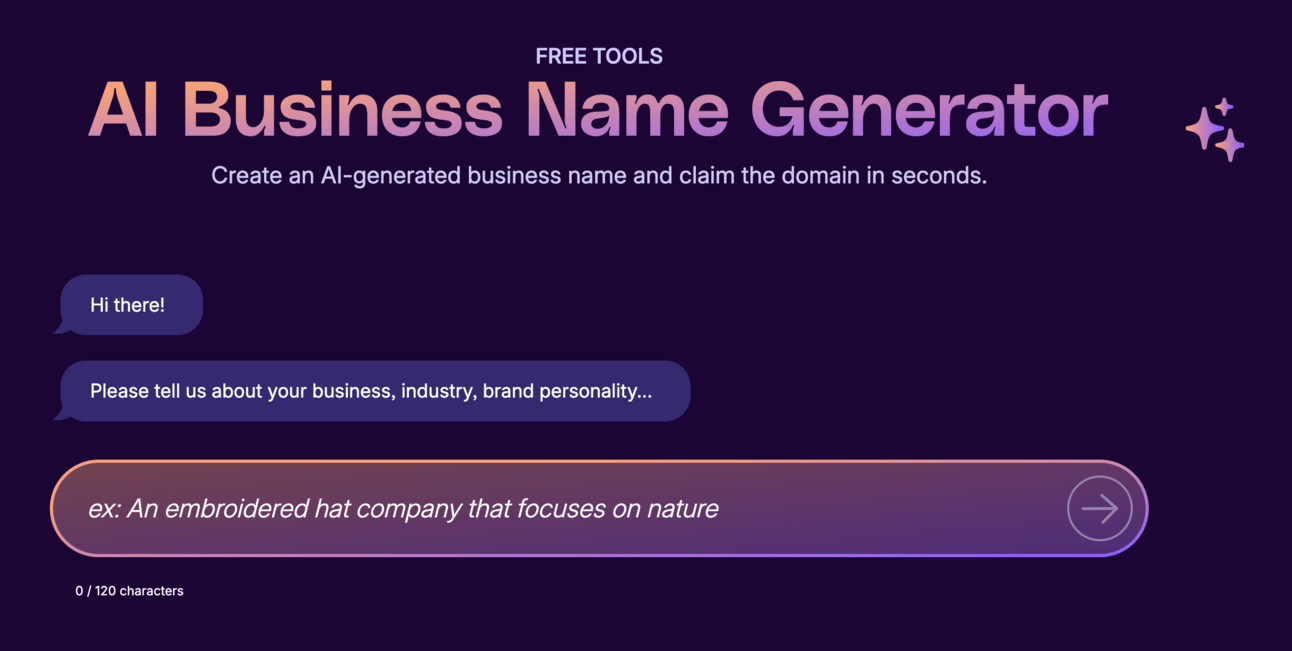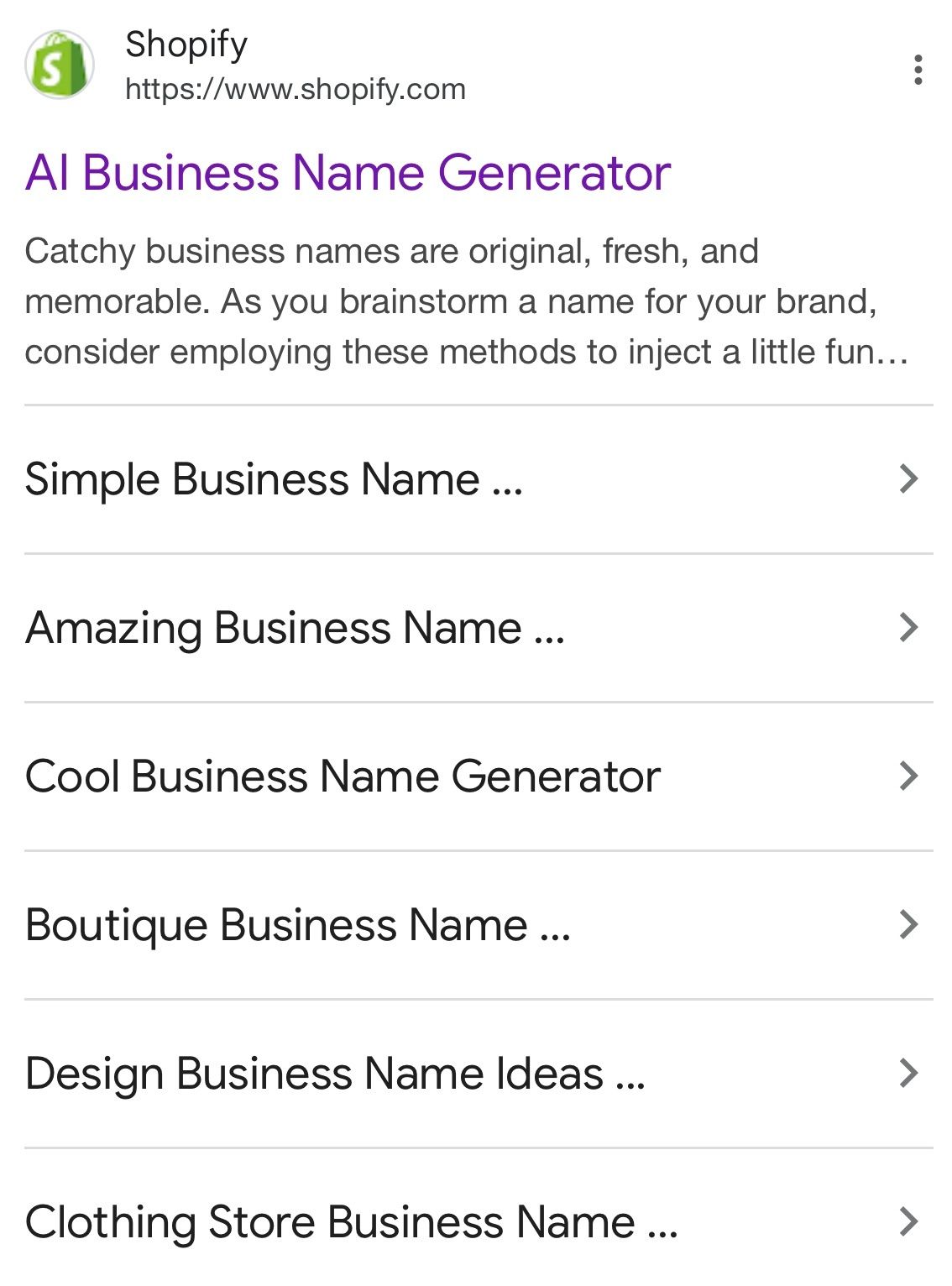Part 1 - Single Serving Tools
.webp)
What’s in a name? A lot apparently.
I know someone who wanted to launch an eCom store. They had their product idea ready to go, but were stuck on the first step - naming their business. Like millions before them, they turned to Google and typed "business name ideas".
Look what pops up:

This search term (“business name ideas”) is searched ~20,000 times a month just in the US. And Shopify is sitting up top with an organic (non-paid) tool.
Click in and this is what you see:

A simple AI business name generator. Type in a few keywords about your business, get a list of catchy names.
But here's where it gets interesting - not only did it generate names, it automatically checked domain availability and offered to register it right there. And of course, would you like to set up your Shopify store with that domain? Just pop in your email...
Genius. Pure genius.
What fascinates me isn't just how well it works (though it does), but how simple it is under the hood. It's essentially just a wrapper around an AI model, doing something that ChatGPT could do.
The kind of thing you and I could write a prompt for with our hands tied behind our backs.
But here's the thing - most people won't think to use ChatGPT for this. And even if they do, they want the convenience. They want the immediate domain check. They want the seamless next step. And they’ll give their email over no problem for this convenience.
This is the opportunity we're diving into this week - building AI-powered micro-tools that solve specific problems and capture leads. Five years ago, building something like this would have been a serious development project. Now? You could have it up and running in an hour.
Let’s get started:
- The power of single-serving AI tools
- Why micro-tools are perfect lead magnets
- Finding problems worth solving
- Building fast and lean
- Getting traffic and leads
Keep it small
Here's what makes these tools so powerful: they do one thing, and they do it well. They're not trying to be everything to everyone. They solve a specific problem at the exact moment someone needs it solved.
Think about it - when someone searches "business name ideas", what do they want? They want business name ideas! They don't want a 20-page guide on branding. They don't want to join your marketing course. They want names, and they want them now.
This is where micro-tools shine. They provide immediate value. No fluff, no fuss, just results.
This should ring a bell if read my Playbook on lead magnets. We want our lead magnets to provide ONE thing very easily and quickly.
We've come a long way from lead magnet ebooks. Don't get me wrong - those still work. But micro-tools? They're different. Here's why:
- Immediate Value: Users get results right away
- Higher Perceived Value: It's a tool, not just information
- Natural Lead-In: The upsell feels helpful, not pushy
- SEO Benefits: Tools get amazing search traffic
- Viral Potential: People share useful tools
All of this can happen with regular lead magnets but its’s much easier with a tool.
The "Just a Wrapper" Philosophy
Here's the secret that makes this all possible: most of these tools are just wrappers around existing AI capabilities. Could someone open ChatGPT and get business name ideas? Sure! Could they then manually check domain availability? Of course!
But they don't want to. They want it all in one place, beautifully packaged, ready to go.
Here’s my general thoughts on “Wrappers”:
1. First people need to think to use ChatGPT for a task. Most won’t.
2. Then they need the skill to build and test a good prompt to get the task done. Most don’t.
3. Finally,
even if they have the skills not everyone has the time. In fact the best customers don’t have time.
- First people need to think to use ChatGPT for a task. Most won’t.
- Then they need the skill to build and test a good prompt to get the task done. Most don’t.
- Finally, even if they have the skills not everyone has the time. In fact the best customers don’t have time.
There will always be people who DIY solutions.
Those people are NOT our future customers. And if they do (mistakenly!) buy from us they’ll be our worst customers. You’ll get emails about how they could have done it themselves, about minor errors they find and general moaning. You’ll have to fire them as customers (I say this as someone who just did this to the tune of $2000 yesterday! Worth it to remove the headache.)
This is our opportunity. We're not building complex AI models. We're not coding revolutionary new algorithms. We're just making existing capabilities more accessible and user-friendly.
Building Your Portfolio
Our play here is SEO - search engine optimisation. This is a fancy way to say “getting to the top of Google”. We’re doing this to drive traffic and thusly email collection. Those emails? Into our sales funnels to become customers. Remember the business case for everything we do - don’t forget.
The real power comes when you start building multiple tools. Each one might be:
- Solving a specific problem
- Ranking for specific keywords
- Capturing targeted leads
- Leading to natural upsells
Let’s look at Shopify again for example:

They have their main “generic” generator. And then one for each of the SEO terms people search for:
- simple business name ideas
- design business name ideas
- clothing store business name ideas
Each of these will carve out a portion of traffic - a few hundred or thousand visits each a month. All adding up to a much larger cumulative figure.
And…knowing what we know about AI prompts what’s happening here?
Yup - they are just adjusting a word or two in the prompt in the background. Adding into the prompt clothing, design, simple and otherwise leaving it identical.
It's like building a portfolio of tiny lead-generating machines, each one working 24/7 to bring you qualified prospects. That’s the plan in this Playbook.
What's Next?
Over the next four parts, we're going to build this out step by step:
Part 2: Finding Problems Worth Solving We'll dive into research methods to find high-demand, easily-solvable problems. You'll learn how to spot opportunities that others miss.
Part 3: Creating Your AI Solution You'll learn how to create clear instructions that turn AI models into reliable tools. No coding required.
Part 4: Extracting Existing Solutions We'll look at how to find proven solutions and convert them into AI-powered tools.
Part 5: Building and Distribution Finally, we'll cover the technical bits - how to build and launch your tool, and most importantly, how to get it in front of the right people.
Remember, every successful tool started with someone noticing a problem and thinking "I could make that easier."